[ad_1]
Regular commentator on this blog, Clive Parry, has written a note on how the banking system and government and commercial bank money creation work, which I have published this morning.
Let me be clear: I agree with everything that Clive has said until he reaches his discussion of the consequences of money creation on the banking system. That is in paragraph 3(3). Even then, I do not dispute what he says about what those consequences that are within the construct of current regulation, and from paragraph 6, our thinking merges again. What I am disputing is not what those familiar with the banking, finance and bond trading systems suggest it is but what it should be.
I am aware that it could be said as a result that I am defying the logic of David Hume when doing so. I am seeking to develop an ‘ought’ from an ‘is’. I would disagree. My suggestion is that if the facts are themselves a reflection of ethical judgement then we can most certainly develop them from what is into what ought to be.
And I am saying we have much about the banking system wrong. That should not be a particularly difficult suggestion to make. If a great many people, including in all likelihood the majority of bankers, think that banks are intermediaries between savers and borrowers, when we know that is not the case, it would not be surprising if a system of regulation created before that was widely recognised is also inappropriate, and wrong. In summary, I am saying that the Basel capital requirement regulations used by banking throughout most of the world are bound to be wrong because they are premised on a misconception of the ultimate source of money creation, which is now base money created by direct government funding of their economies.
What Clive makes clear in his comments, is that banks are forced to lend to each other if their central bank reserve account balances move out of line as a consequence of interbank payments. This is because banks are not permitted to make long-term loans that are funded by what are, in effect, overnight loans from their central banker, which is what central bank reserve accounts are deemed to be because this was their nature prior to the 2008 global financial crisis, when the balance is held upon them were, in current terms, insignificant.
Prior to 2008, the Bank of England what is seen as a lender of last resort to banks. As a result, central bank reserve account balances were frequently less than £30 billion in aggregate. As a consequence, they were an insignificant asset on the balance sheet of all the UK’s clearing banks, with similar situations arising in banks around the world. Since then, this has happened in the UK, with this situation broadly being replicated worldwide:
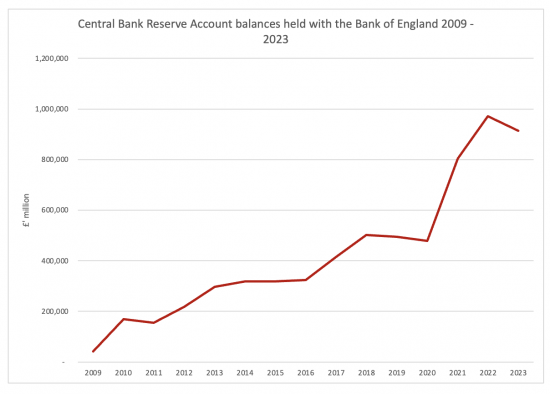
Far from being insignificant sources of funding, central bank reserve accounts held by banks with their central banker are now major assets of most major banks. This is not the result of QE, I stress (because that is a sham): it is the result of government deficit funding of its spending financed by the Bank of England.
I looked at this issue in August last year, when I reviewed the impact of central bank reserve accounts on the balance sheets of the UK’s five largest retail banks (Barclays, HSBC, Lloyds, NatWest, Santander). As I noted then, the existence of central bank reserve account balances in the sums that are now in use has had a profound impact on their operations. Take this table, which shows the scale of the central bank reserve account balances held by these banks:
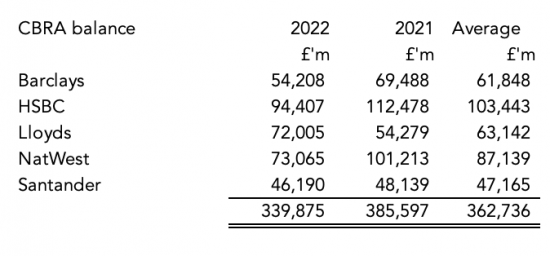
To give an indication of the significance of these sums note these tables:
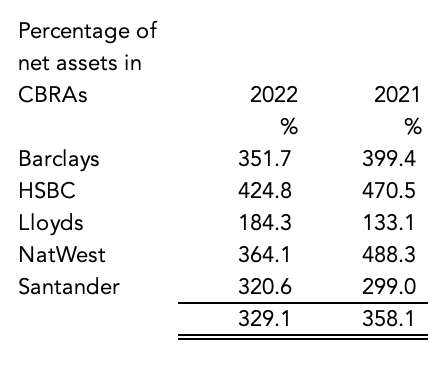
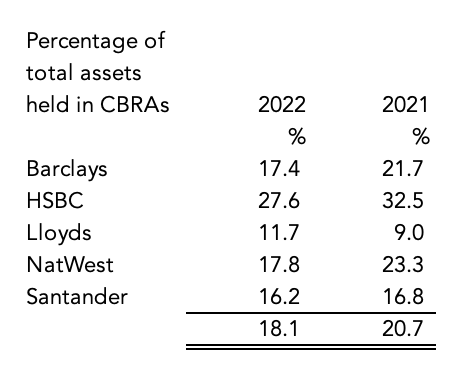 These are massive changes from the era when central bank reserve accounts were insignificant. The balance sheets of these banks now make no sense without considering the central bank reserve account balances.
These are massive changes from the era when central bank reserve accounts were insignificant. The balance sheets of these banks now make no sense without considering the central bank reserve account balances.
There has also been a massive impact on profit:
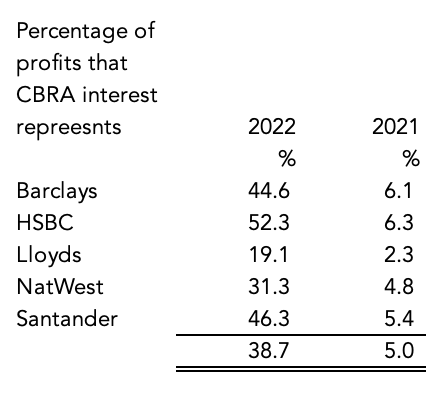
To put that in context, note this data for 2022:
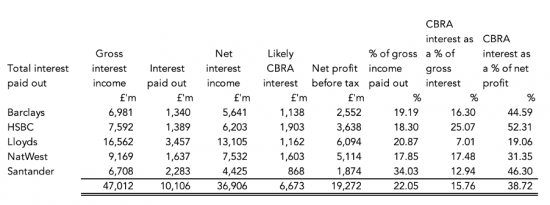
CBRA interest averaged 38.7% of profit, but also covered more than 65% of interest paid to customers in 2022. The scale of the change was also staggering: this is the 2023 data on interest earned:
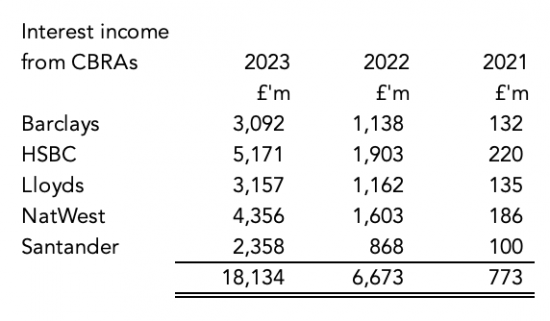
All of this, supposedly, is not happening in the world Clive Parry describes where it is assumed that banks cannot rely on overnight funding from their central bank when it makes up an average of 18.1% of their net assets in 2022. That is ludicrous. It is pretending the world as it is does not exist.
So, why is that? I suggest that there are four reasons:
- It’s too hard to change Basel. Regulatory inertia is requiring that the pretence that the world is as it was and not as it is must be maintained.
- Basel does not understand that banks are not intermediaries. It would seem very likely that this is the case.
- It suits banks to pretend that QE will be unwound when we know that the process of doing so–called quantitative tightening – which is being pursued by the Bank of England right now has nothing to do with QE but is instead a policy to keep interest rates artificially high in a wholly destructive fashion that does, however, suit the bank agenda of upward redistribution of income.
- It denies the reality that banks really do not exist independently of each other, they cannot be regulated in isolation, and none of them are too big to fail, meaning that the pretence implicit in Basel that they are not too big to fail can be maintained. We know that this is nonsense.
Of these, the last is, to me, the most important. The reason why banks are not allowed to fund themselves using overnight funds from central banks is not because this is not possible (it always has been), and nor is that because this should be seen as a last resort, which given the existence of central bank reserve account balances is clearly not the case, but because the pretence is being maintained that the banks must regulate each other through their interbank lending. This is the supposed indicator of stress to which the central banks want to look.
That, however, makes no sense. When the banking system as a whole is now utterly dependent upon the availability of central bank funding to maintain its liquidity, as the Truss debacle proved amongst other things, then to pretend that reliance on interbank lending is the indicator of bank stress is simply wrong. In the current environment, what a central bank needs to know is the degree of dependence that a bank has on its central bank borrowing to fund this activity, and this is where stress would be best measured. In that case, the current regulatory environment that creates the funding situation that Clive accurately describes, is counter-productive. When it is the action of a single bank that can threaten the system as a whole, what a central bank like the Bank of England needs to know is whether one bank is advancing funds in a fashion out of step with the action of other banks, which would clearly be indicated by its central bank reserve account falling disproportionately, which fact could be hidden by interbank lending. It would, therefore, I suggest make much more sense to regulate via the CBRA’s, rather than to deny their use for this purpose. This would also save much of that, I suggest pointless, activity in Treasury functions to which Clive refers. But most importantly, systemic risk would become more apparent more quickly, and that seems to me to be key.
Have I got something wrong, or am I simply refusing to think as bankers want me to do?
Finally, my thanks to Clive: he made me think in more depth about this issue.
[ad_2]
Source link

